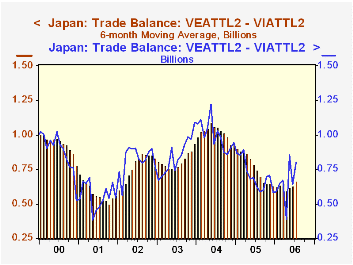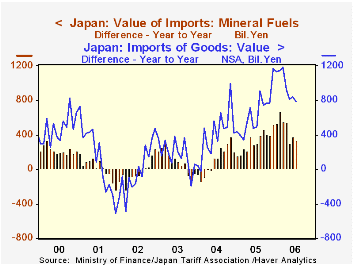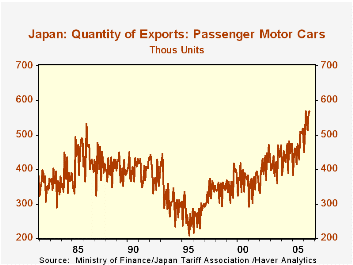 Global| Aug 23 2006
Global| Aug 23 2006Japan Trade Surplus Helped by More Car Exports, Flatter Oil Imports
Summary
Japan's trade balance appears to have stabilized after a surge in petroleum imports cut it back last year. In July, the balance was ¥800 billion, up from ¥624 billion a year ago and an average of ¥726 billion for 2005. Obviously, [...]

Japan's trade balance appears to have stabilized after a surge in petroleum imports cut it back last year. In July, the balance was ¥800 billion, up from ¥624 billion a year ago and an average of ¥726 billion for 2005. Obviously, though, as the three months of data in the table below show, the balance moves around a good bit. But a six-month moving average makes the stabilization clearer, as illustrated in the first graph.
The role of fuels imports in the erosion of the traditionally sizable Japanese trade surplus is indicated in the second graph. Since late 2004, right at half of the year-on-year yen increase in imports has come from "mineral fuels". No other single major category has a significant share of the growth. At the same time, both petroleum and total imports have leveled out in the last few months, easing the pressure on the trade balance.
Exports have also helped the trade balance. Also a bit erratic from month-to-month, foreign sales have picked up, with a 14.2% increase on the last year, nearly double the average growth in 2005. Several sectors have contributed, with good gains in machinery, non-automotive transport equipment and "other" exports. However, the biggest increase has been in motor vehicles, which are up a whopping 26.2% in July from July 2005. Details from the Ministry of Finance show that the number of passenger cars exported was a record last month, 569,000. This is an extraordinary development. The last time figures were nearly as high was in the mid-1980s, as seen in graph 3. At that time, Japanese makers produced a relatively small number of their cars in the US compared to the present and until just the last few months, truck sales have dominated motor vehicle demand, at least in the US. The move back to more fuel-efficient cars is well along, giving an ironic boost to the Japanese trade surplus.
| Japan, Bil.¥, Seas Adj.* | July 2006 | June 2006 | May 2006 | July 2005 | Monthly Averages|||
|---|---|---|---|---|---|---|---|
| 2005 | 2004 | 2003 | |||||
| Trade Balance | 800 | 639 | 854 | 624 | 726 | 996 | 849 |
| Exports | 6335 | 6139 | 6124 | 5410 | 5471 | 5097 | 4546 |
| % Change | 3.2 | 0.2 | 1.3 | 14.2 | 7.3 | 12.1 | 4.7 |
| Imports | 5535 | 5499 | 5271 | 4786 | 4746 | 4101 | 3697 |
| % Change | 0.6 | 4.3 | -6.9 | 16.8 | 15.7 | 10.9 | 5.1 |
Carol Stone, CBE
AuthorMore in Author Profile »Carol Stone, CBE came to Haver Analytics in 2003 following more than 35 years as a financial market economist at major Wall Street financial institutions, most especially Merrill Lynch and Nomura Securities. She had broad experience in analysis and forecasting of flow-of-funds accounts, the federal budget and Federal Reserve operations. At Nomura Securities, among other duties, she developed various indicator forecasting tools and edited a daily global publication produced in London and New York for readers in Tokyo. At Haver Analytics, Carol was a member of the Research Department, aiding database managers with research and documentation efforts, as well as posting commentary on select economic reports. In addition, she conducted Ways-of-the-World, a blog on economic issues for an Episcopal-Church-affiliated website, The Geranium Farm. During her career, Carol served as an officer of the Money Marketeers and the Downtown Economists Club. She had a PhD from NYU's Stern School of Business. She lived in Brooklyn, New York, and had a weekend home on Long Island.





